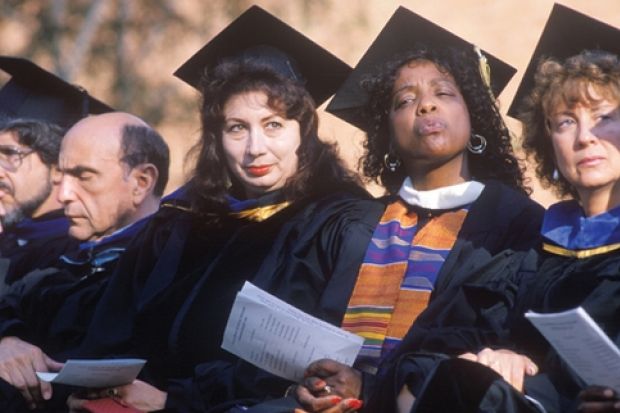The stubborn disparity in the salary levels of male and female academics in the US has been highlighted by an annual survey of faculty pay.
Figures published this week by the American Association of University Professors (AAUP) indicate that, on average, female academics were paid around a fifth less than their male counterparts in 2010-11: $71,237 (£43,712) compared with $88,024.
The disparities are widest in private institutions, where the average salary earned by men was 26 per cent higher than that earned by women. The gap was also particularly notable at professorial level: male professors earned an average of $114,421 compared with $100,231 for women.
There are also far more men than women holding top academic positions. Nearly a quarter of all academics in the US are male professors, whereas less than one in 10 are female professors.
Publishing its analysis on 11 April, the AAUP said that "while the great recession in the broader US economy may be over, the same cannot be said for higher education".
It noted that, sector-wide, salary levels are only marginally better than they were last year. The overall average salary has increased at a rate below inflation for the second year in a row.
The union's report, It's Not Over Yet: The Annual Report on the Economic Status of the Profession, 2010-11, also highlights the growing proportion of US academics who are in part-time, non-tenure-track positions.
In 2009, graduate students and so-called contingent faculty made up more than 75 per cent of the total teaching workforce. "Even with the substantial impact of the recession already documented, our forecast for the near future is not encouraging," the AAUP said.
"States will continue to struggle with reduced revenue, and that means decreased state funding for the majority of all institutions that are in the public sector.
"At the same time, governors in a number of states have been using the fiscal crisis as a pretext for a broad attack on public-employee compensation."
Meanwhile, data released by the Canadian Association of University Teachers (CAUT) show the extent to which the academic gender pay gap north of the border has shrunk since the mid-1980s.
In 1986, female academics in Canadian universities earned an average of 19 per cent less than their male colleagues, but 20 years later this gap had narrowed to 11 per cent.
Penni Stewart, president of the CAUT, suggested that the continuing pay disparity in the US may be because of the low level of unionisation in the academy.
Professor Stewart, an associate professor of sociology at York University in Toronto, added that the reduced pay gap in Canada was largely attributable to union activity.
"Less unionised sectors still have much bigger wage gaps between men and women. I think that (unionisation) provides rules for employers and standardises things. You can no longer make private deals with someone who seems a bit more attractive," she said.
Despite the improvements in pay equity in Canada, and the fact that the number of female academics has doubled in the past 20 years, women still account for less than a third of all faculty at universities and colleges in the country.
Professor Stewart acknowledged that "there are lots of issues that remain. It's not all lovely. But at the same time we have achieved something," she observed.
"I was first hired in 1990. Now, for the first time, colleagues are feeling that they can have children (as well as a career), and that is a result of better parental care policies. You don't feel you have to give up your career any more."
However, she warned that the CAUT review did not offer an all-encompassing view of Canadian higher education.
"What you're seeing reflected in the equity review is only for full-time academics. We have no data on part-time or contract academic staff in Canada," she said.
"It's a huge problem and, as someone who works with statistics, I can say that it is a complete embarrassment."
Approximately 80 per cent of teaching at Canada's higher education institutions is done by contingent staff.
Professor Stewart said this figure also pointed to gender equality, as a large proportion of faculty on part-time contracts were women.
"The problem we have is that the gains women have made are very fragile in the face of the kinds of pressures that are coming down on us now," she said.
